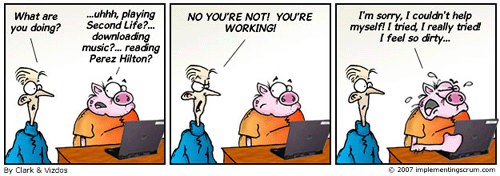|
Software Development Magazine - Project Management, Programming, Software Testing |
|
Scrum Expert - Articles, tools, videos, news and other resources on Agile, Scrum and Kanban |
Opening Communication Within a Scrum Team During the Daily Meeting - Part 2
Mike Vizdos, www.implementingscrum.com
Team Y -- Scrum Meeting -- 8:38 AM Tuesday Morning
The room for the Daily Scrum Meeting is the same room where the team completes their work on a daily basis as a collocated team. Information radiators abound -- including a Story Board, a BurnDown Chart and Team Norms.
The Scrum Team has been together for about four months, and know that the main reason for the Daily Scrum Meeting is to keep it under fifteen minutes so that the team can get together and coordinate what has occurred since the last meeting (normally yesterday!), what will happen today, and what impediments are slowing people down.
They know it is not a daily status report to anyone. It is for the team.
Most of the Scrum Team members are there and the meeting started promptly at 8:30 AM. The ScrumMaster is absent and the team is not concerned as they know the ScrumMaster is not a traditional Project Manager of past waterfall projects they have worked in (before moving to more agile software development techniques).
They also know the ScrumMaster would not be here today, as a personal item came up with the family that takes priority over any work they are doing. The team has a sense of a work-life balance and tries to hold each other accountable to make sure this team norm is followed by everyone on the team.

They are in the process of building a high performing team, and their ScrumMaster has facilitated the team to get through the forming, storming, and norming cycles of team development (as they learned about from a model by Bruce Tuckman and some corny exercises along the way).
One of the team members walks in at 8:38, clearly late for the meeting. Without hesitation, the late Scrum Team Member walks over to the corner with an extra large pickle jar, silently opens it, and starts chomping away. The late team member joins the circle that has formed for the group this morning.
Everyone is standing up. Everyone in attendance is keeping focused on the three questions that should be addressed by each person during this meeting:
- What have I completed since yesterday?
- What will I complete before our next Daily Scrum Meeting?
- What are my impediments?
Nobody controls the meeting or takes notes and one can feel the respect level among the team members speaking with the others.
One of the team members is having a hard time with a technical task, and knows this is not the time to dig down into a solution -- this is what they do during the day as the team is collocated and working together toward a common Sprint Goal. This team member brings it up as an impediment, and another team member agrees to follow-up with them after the Daily Scrum Meeting in order to remove the impediment together. Someone makes a note of it on the whiteboard listing out impediments and who is working on them, since they need to keep track of this kind of stuff for compliance purposes.
One of the team members starts to talk about a party being planned for tonight after work. The rest of the team, knowing that this is not part of what they should be discussing right now, reminds her of the three questions and asks that she please focus on helping get this Daily Scrum Meeting completed. She passes.
Story cards during this meeting are moved from "Not Started" to "Work in Process" to "Done" as needed. The feeling of "waterfall" projects is nowhere to be felt in this room; the team is focused on a very clear Sprint Goal that delivers specific business value at the end of this Sprint.
At the end of the meeting one of the team members adds up the hours remaining for the tasks in the Sprint, and updates the Burn Down Chart.
They all look at the Burn Down Chart and see if they are on track to complete the Sprint, and agree that all looks well right now. They agree with the Product Owner -- who is present -- to make sure they keep in touch during the day with the possible impediment mentioned earlier because they know they may have to de-scope a story from the Sprint Backlog and put it back onto the Product Backlog for future prioritization. Their is no sense of "us" versus "them" -- clearly this is one team working toward a specific goal who understand the larger picture and business implications of what they are delivering.
Throughout this Daily Scrum Meeting, a Senior VP has been standing outside the circle the team has formed around a small folding table with toys all over it, listening to what is happening -- real time. And. She has been quiet throughout the meeting since she knows she is not a contributing team member (she was a little ticked about being called a "Chicken" but now realizes the real difference between a Chicken and Pig as the metaphor for this Scrum Team).
It is 8:44. The meeting is over in under the maximum of fifteen minutes. The team breaks out into pairs and starts their daily work within their collocated room; they have a clear understanding of what needs to happen today and is excited about working together towards a real business solution.
|
Methods & Tools Software Testing Magazine The Scrum Expert |



